INTRODUCTION
Dragon fruit (Hylocereus spp.) has garnered significant scientific interest due to its unique nutritional profile and potential health benefits [1]. The growing consumer demand for functional and novel beverages has spurred research into fermented dragon fruit products [2]. This trend necessitates a comprehensive investigation of innovative processing techniques to optimize both the nutritional value and sensory attributes of dragon fruit beverages.
Recent advancements in fruit beverage processing have introduced several approaches to dragon fruit utilization, including ultrasound-assisted extraction [3], high hydrostatic pressure processing [4], and membrane filtration techniques [5]. Despite these innovations, challenges persist in optimizing both the extraction of beneficial compounds and the subsequent fermentation process, particularly for alcoholic dragon fruit beverages.
Enzyme-assisted extraction has emerged as a promising technique for improving juice yield and releasing bound phenolic compounds from fruit matrices [6]. By employing specific enzymes such as pectinases, this method can enhance the extraction of fermentable sugars and other compounds that contribute to the final product’s sensory profile [7]. In the context of dragon fruit processing, enzyme-assisted extraction offers the potential to maximize the release of bioactive compounds and improve overall juice quality.
Mixed culture fermentation, particularly utilizing S. cerevisiae in combination with other microorganisms, has shown considerable promise in creating complex flavor profiles and achieving precise control over ethanol production [8]. Saccharomyces cerevisiae, renowned for its efficient ethanol production and tolerance, serves as the primary fermentation agent [9]. A mixed culture fermentation approach to fermentation allows for the development of unique sensory characteristics in the final dragon fruit beverage. However, the S. cerevisiae inoculation rate and fermentation time are critical for controlling the fermentation process [10]. These factors can affect ethanol yield, fermentation efficiency, and the development of flavor compounds [11].
To systematically investigate and optimize this multifaceted process, response surface methodology (RSM), specifically the central composite design (CCD), offers a robust statistical framework. RSM-CCD enables the modeling of relationships between multiple process variables and their effects on key outcomes, facilitating efficient exploration of the experimental space and identification of optimal conditions [12]. This approach is particularly well suited for optimizing complex processes such as the combined enzyme-assisted extraction and mixed culture fermentation of dragon fruit beverages.
In this study, we propose a synergistic combination of enzyme-assisted extraction and mixed culture fermentation, utilizing S. cerevisiae HG 1.3 as the primary fermentation agent, optimized through RSM-CCD. Our experimental design focuses on three critical aspects: (1) the impact of pectinase enzyme concentration on extraction efficiency, (2) the combined effect of soluble solids content and pH on the pre-fermentation medium, and (3) the interplay between S. cerevisiae inoculation rate and fermentation duration. The evaluated parameters included ethanol content, pH, total sugar, and total soluble solids (TSS).
We hypothesize that this integrated approach will yield a superior dragon fruit beverage compared to traditional methods or single-technique innovations. By elucidating the complex interactions between enzyme-assisted extraction and mixed culture fermentation, optimized through RSM-CCD, we aim to establish a robust methodological framework for dragon fruit beverage production.
The findings of this research have the potential to significantly impact the fruit wine industry, offering insights into the development of innovative, high-quality dragon fruit-based alcoholic beverages, particularly dragon fruit beverages. Moreover, this study contributes to the broader field of food science by demonstrating the efficacy of a multifaceted, statistically rigorous approach to process optimization in fruit beverage production.
MATERIALS AND METHODS
Raw Materials
The primary raw material used in this study was dragon fruit (Hylocereus undatus Haw.), sourced from the local Xuan Khanh markets in Ninh Kieu District, Cantho City. The fruits were selected for uniform size, color, and ripeness to ensure consistency. The dragon fruits were washed, peeled, and cut into small pieces. The juice was extracted using a hydraulic press and then filtered to remove any solid particles.
Sucrose (>99.7%) used was acquired from Bien Hoa sugar company, Dong Nai, Vietnam. Citric acid, sodium bisulfite (NaHSO3), ethanol, and peptone dextrose broth were purchased from Xilong, China. Pectinase enzyme was procured from ICFOOD company, Ho Chi Minh City, Vietnam.
Saccharomyces cerevisiae HG 1.3, which performed high fermentation ability [13,14], was isolated from Cayratia berries [15] and obtained at the Microbial Biotechnology Laboratory, Institute of Food and Biotechnology, Can Tho University, Vietnam. A single colony was added to 100-ml yeast peptone dextrose broth (10-g/l yeast extract, 20-g/l peptone, and 20-g/l D-glucose), which had been sterilized at 121°C for 15 minutes and then was shaken at room temperature (28°C ± 2°C) to obtain a rate of 108 cells/ml. Subsequently, the addition of S. cerevisiae HG1.3 was inoculated to dragon fruit beverage for fermentation.
Saccharomyces cerevisiae RV002 yeast: Commercial product used in wine fermentation (Angel Yeast) was obtained from the Microbiology Laboratory, Faculty of Biological, Chemical and Food Technology, Can Tho University of Technology, Can Tho, Vietnam. The yeast was activated with warm water at a temperature of about 30°C–40°C for 15 minutes before the experiment.
Experimental Design
The research was conducted through a series of controlled experiments to optimize the fermentation process of dragon fruit juice. The experiments focused on the impact of various factors, including pectinase enzyme concentration, soluble solids content, pH levels, yeast ratios, and fermentation durations, on the quality of the fermented product.
Effect of Pectinase Enzyme Concentration on the Juice Yield
The pectinase enzyme was used to break down pectin in the dragon fruit juice, aiding in the clarification and fermentation process. The extracted dragon fruit juice underwent a pectinase enzyme treatment to improve juice yield and clarity resulting in reduced viscosity and enhanced juice extraction. Different concentrations of pectinase enzyme of 0.03%, 0.035%, 0.04%, and 0.045% (w/w) were used, and meanwhile, the mixture was incubated at 50°C for 120 minutes to determine the optimal concentration for maximum juice yield. The nonenzyme sample was treated as the control.
Impact of Soluble Solids Content and pH Levels
Dragon fruit juice was assessed by adding the pectinase enzyme (0.04% w/w) step. Then, to assess the effect of soluble solids content and pH levels on fermentation, the dragon fruit juice was adjusted to three different soluble solids levels of 20.0°, 22.0°, and 24.0°Brix) using sucrose; additionally, the pH was adjusted to 3.8, 4.2, 4.6, and 5.0 using citric acid or sodium hydroxide. Pasteurize the fruit juice with 120-mg/l NaHSO3, stir well, and let stand for 120 minutes. Add yeast growth solution S. cerevisiae HG 1.3 at a ratio of 1% (v/v) and yeast S. cerevisiae RV002 at a ratio of 0.04% (w/v). The juice samples were then inoculated and allowed to ferment at 28°C–30°C for 48 hours without shaking.
After fermentation, the dragon fruit juice was filtered to remove any residual yeast cells and other particulates. The filtered juice was then pasteurized to ensure microbial stability and extend shelf life. The final product was bottled and stored under refrigeration and evaluated through quality assessment.
Impact of Yeast Ratio and Fermentation Time
The juice with optimal soluble solids content and pH level was then occupied the same steps as the previous experiment. The samples were sterilized with NaHSO3 (120 mg/l) for 120 minutes. Then, natural yeast S. cerevisiae HG 1.3 was added to the juice in varying ratios of 1.0%, 1.5%, and 2.0% (v/v), respectively. Meanwhile, every sample was added S. cerevisiae RV002 (0.04% w/v). The fermentation process was monitored over different time periods (24, 48, and 72 hours).
The dragon fruit cider was then undergone the post-fermented steps as mentioned previously.
Quality Assessment
The quality of the fermented dragon fruit juice was assessed through both sensory and chemical analyses. Sensory evaluation included assessing the color, aroma, and taste of the juice by a panel of trained judges according to Vietnam National Standard 3217:79. Chemical analysis involved measuring the water content, soluble solids concentration, pH, alcohol content, and total sugar content using standard analytical methods.
Soluble solids concentration was measured using a refractometer. The pH level was determined using a digital pH meter. The alcohol content was assessed through distillation followed by measurement using an alcoholmeter. Total sugar content was analyzed using the phenol–sulfuric acid method.
Data Analysis
The experimental data were analyzed using statistical methods to determine the significance of the different factors on the fermentation process and the quality of the final product. Analysis of variance was conducted to identify significant differences among the treatments, and a CCD was used to model the relationship between the variables and the quality attributes of the fermented juice. In the pre-fermentation process, we examined two independent variables soluble solids content and pH Levels. In the fermentation process, we examined two independent variables yeast ratio and fermentation time. The selected response variables were soluble solids concentration, pH, alcohol content, and total sugar content. Python using libraries, such as pandas, numpy, statsmodels, and matplotlib, were used to fit the quadratic response surface model to the experimental data.
RESULTS AND DISCUSSION
Initial Conditions of Dragon Fruit Juice Before Fermentation
The initial parameters of the dragon fruit juice prior to fermentation were measured and recorded in Table 1. These parameters included water content (%), soluble solids content (°Brix), pH, and total sugar content (%). The data provide a baseline for evaluating the changes and effectiveness of the fermentation process.
 | Table 1. The initial parameters of the dragon fruit juice prior to fermentation. [Click here to view] |
The dragon fruit in our experiment had a value of 10.33°Brix and a total sugar of 7.85% ± 0.03%, which suggests that the juice has a moderate sugar content. For alcoholic fermentation, this might be considered on the lower side, as yeasts require sugars to produce alcohol. Winemakers often aim for higher Brix levels (around 20–25) for optimal fermentation [16]. We considered adding sugar to increase the Brix as the juice had the right amount of soluble solids for the yeast to use during the fermentation process while also enhancing the flavor of the product.
The results showed that the pH level (4.47 0.02) was slightly acidic, which is common for many fruits. It is within a favorable range for yeast activity, as most yeasts perform well in slightly acidic environments (pH 4–6) [17]. This pH should help inhibit the growth of many unwanted bacteria while still allowing yeast to thrive. We then conducted some slight adjustments of pH to suit the standards of fermented juice to get the desired fermented dragon fruit drink product.
Effect of Pectinase Enzyme Concentration on the Juice Yield
The impact of pectinase enzyme concentration on the juice recovery efficiency from dragon fruit was examined. Various concentrations of the enzyme (0.03%, 0.035%, 0.040%, and 0.045% w/w) were tested to determine the optimal amount needed to maximize juice yield (Fig. 1).
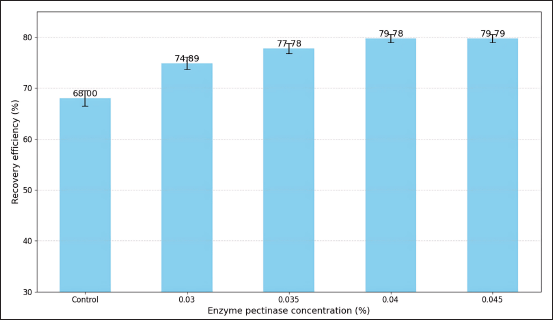 | Figure 1. The impact of pectinase enzyme concentration (0.03%, 0.035%, 0.040%, and 0.045%) on the juice recovery efficiency from dragon fruit. [Click here to view] |
The results showed that increasing the concentration of pectinase enzyme led to higher juice yields. At an enzyme concentration of 0.040%, the highest juice yield efficiency was observed, reaching a peak efficiency of 79.78%. Concentrations above 0.040% did not yield significantly higher recovery rates, suggesting a plateau in the enzyme’s effectiveness. Therefore, maintaining the enzyme concentration at 0.040% is recommended for optimal results. This indicates that 0.040% is optimal for breaking down pectin substances in the dragon fruit, facilitating better extraction of juice, which is easier to process and more visually appealing. The reason may be that the enzyme treatment facilitated the breakdown of cell walls and the release of intracellular substances, contributing to a smoother texture and more pronounced flavor profile [18,19]. These findings are critical for optimizing the fermentation process and can be applied to improve the production efficiency and quality of fermented dragon fruit juice on a commercial scale. Future studies could explore the interactions between pectinase and other enzymes or additives to further refine the process. Moreover, further research could explore the long-term stability and nutritional impact of the enzyme treatment on the final product.
The Impact of Soluble Solids Content and pH Levels on the Pre-Fermentation Process of Dragon Fruit Beverage
On the pre-fermentation process of dragon fruit beverage, we utilized a CCD to optimize the pre-fermentation process for dragon fruit beverage, focusing on two critical factors: initial TSS content TSS (°Brix) and initial pH (Table 2). The relationships between these factors and dependent variables (ethanol content, pH, total sugar, and TSS) were modeled using a quadratic regression approach (Table 3).
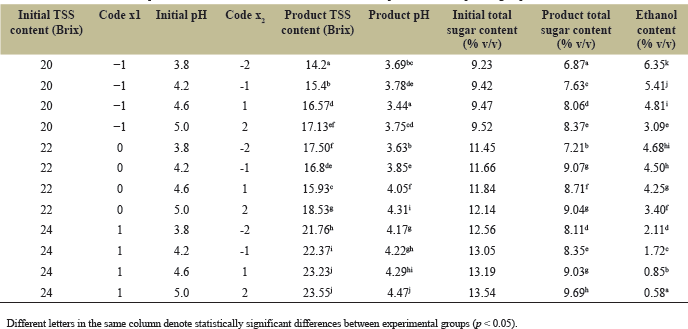 | Table 2. CCD matrix of independent variables (initial TSS content and initial pH) with corresponding experimental values. [Click here to view] |
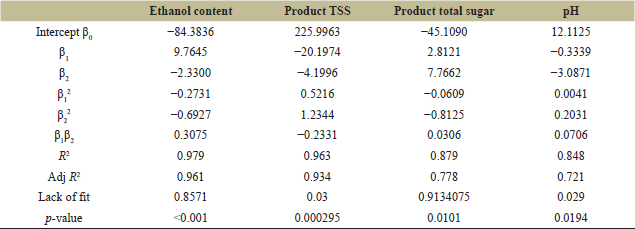 | Table 3. Regression coefficients of the predicted second-order polynomial models of TSS and pH for the responses of dragon fruit beverage. [Click here to view] |
The quadratic regression models demonstrated varying degrees of fit, with coefficients of determination (R²) ranging from 0.848 to 0.979. Notably, the ethanol content model exhibited the highest R² value of 0.979 and adjusted R² of 0.961, indicating a strong predictive capacity. These results align with similar studies on fruit beverages, such as the work of M’hir et al. [20] on Myrtle juice, which reported R² values ranging from 0.827 to 0.966 for various quality parameters (pH, total polyphenol content, and antioxidant activity). Besides, all models achieved statistical significance, as evidenced by p-values below the 0.05 threshold. The ethanol content model, in particular, demonstrated a highly significant relationship with a p-value <0.001. This level of significance is comparable to findings by Wang et al. [21] in their study on mulberry fruit wine, where they also reported p-values < 0.001 in the fermentation process. Furthermore, the lack of fit values varied considerably among the models. The TSS and pH models exhibited a relatively low lack of fit values (0.03 and 0.029, respectively), suggesting good model adequacy (Table 3).
The quadratic regression approach fitted to the experimental data provided insights into the relationship between the initial TSS and pH and the resulting ethanol content, product TSS content, total sugar content, and pH (Table 3). The effect of independent variables on resulting dependent variables of dragon fruit beverage was shown as follows:
Ethanol content (% v/v)= -84.3836 +9.7645*X1 -2.3300*X2 -0.2731*X12 -0.6927*X22 +0.3075*X1X2
TSS(Brix)= 225.9963 -20.1974*X1 -4.1996*X2 +0.5216*X12 +1.2344*X22 -0.2331*X1X2
Total sugar (% v/v)= -45.1090+2.8121*X1 +7.7662*X2 -0.0609*X12 -0.8125*X22 +0.0306*X1X2
pH = 12.1125 -0.3339*X1 -3.0871*X2 +0.0041*X12 +0.2031*X22 +0.0706*X1X2
in which X1 is the initial TSS content (°Brix) and X2 is the initial pH.
The positive coefficient for X1 suggested that an increase in the initial TSS content tends to increase the product total sugar content and ethanol content while tending to decrease the TSS content and pH values. However, the negative coefficients for X12 suggested a diminishing return effect, where very high values of X1 could decrease the product ethanol content and total sugar content. On the other hand, the positive coefficient for X2 suggested that an increase in the initial TSS content only tended to increase the product total sugar content while tending to decrease the ethanol content, TSS content, and pH values. Similarly, the negative coefficients for X22 suggested a diminishing return effect, where very high values of X2 could decrease the product ethanol content and total sugar content.
The response surface shows the relationship between initial TSS content, initial pH, the resulting ethanol content, pH, total sugar, and TSS during the pre-fermentation process, which are plotted in Figure 2.
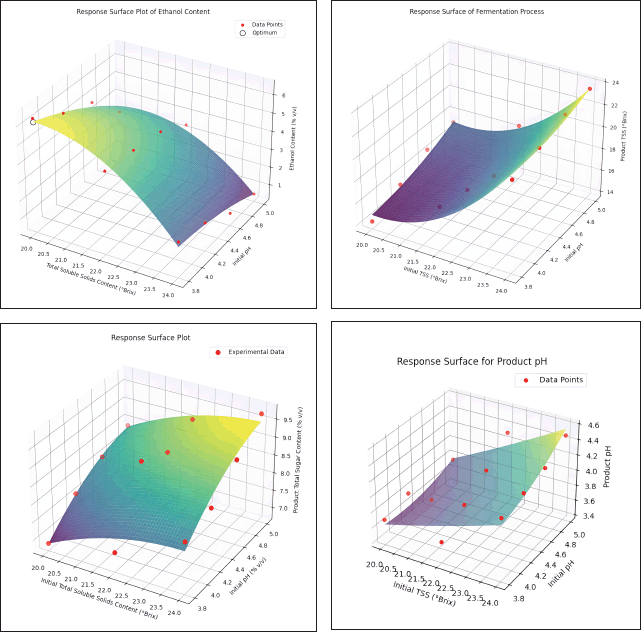 | Figure 2. The response surface shows the relationship between initial TSS content, initial pH, the resulting ethanol content, pH, total sugar, and TSS during the pre-fermentation process. [Click here to view] |
The response surface plot shows the relationship between initial TSS content, initial pH, and the resulting ethanol content (Fig. 2a). The surface exhibits a curved shape, indicating a nonlinear relationship between the factors and the response. Ethanol content appears to be highest (5.41%–6.35% v/v) at lower TSS levels (20–21°Brix) and higher initial pH values (around 4.6–5.0). As TSS increases and pH decreases, there is a general trend of decreasing ethanol content. This relationship could be explained by the yeast’s fermentation efficiency. Higher initial pH may provide a more favorable environment for yeast activity, while lower TSS levels might prevent osmotic stress on the yeast cells. For instance, Al Daccache et al. [22] reported similar trends in apple juice fermentation, where excessive sugar concentrations inhibited yeast activity. This phenomenon, known as osmotic stress, can impair yeast performance at high sugar levels [22]. However, our finding that higher initial pH (4.8–5.0) favors ethanol production contrasts with some studies. For example, Chakraborty and Parab [23] found optimal ethanol production in table grape juice at lower pH ranges (3.0). This difference could be attributed to the unique characteristics of dragon fruit or the specific yeast strains used in our study, highlighting the importance of tailoring fermentation conditions to each fruit substrate, and the pulsed light treatment of green table grape juice.
The plot showed how initial conditions influence the final TSS of the product (Fig. 2b). There is a strong positive correlation between initial and final TSS. Initial pH has a minor effect on final TSS, with slightly higher values at higher initial pH. The highest final TSS (22.37–23.55°Brix) was observed at high initial TSS (23–24°Brix) and high initial pH (4.6–5.0). This relationship suggests that a significant portion of the initial soluble solids remains in the final product, with some reduction due to fermentation. The slight influence of pH on final TSS could be related to the efficiency of sugar utilization by yeast.
The strong positive correlation between initial and final TSS (Fig. 2b), as well as final sugar content (Fig. 2c), indicates incomplete sugar utilization during fermentation. This is a common occurrence in fruit wine production, as noted by Kosseva et al. [24] in their comprehensive review of fruit wine technology. The residual sugars contribute to the final product’s sweetness and body, which can be desirable in certain beverage styles. Our observation that higher initial pH slightly increases final sugar content is interesting and warrants further investigation. It could be related to yeast stress responses or changes in enzyme activity at different pH levels, as suggested by Alagöz Kabakc? et al. [25] in their study on black carrot juice fermentation, where higher initial pH leads to increased residual sugars.
The plot demonstrated how the initial conditions affect the final pH of the product (Fig. 2d). The surface is relatively flat, indicating that the product pH is somewhat stable across different initial conditions. This aligns with observations by Wei et al. [26] in their work on bog bilberry juice fermented by Lactobacillus plantarum under different pH conditions, where the final pH remained fairly constant despite variations in initial conditions. There is a slight increase in product pH as both initial TSS and initial pH increase. The highest product pH values (around 4.05–4.47) are observed at high initial TSS (22–24°Brix) and high initial pH (4.6–5.0). This suggests that the fermentation process has a buffering effect, as the final pH range is narrower than the initial pH range. The slight increase in product pH with higher initial TSS could be due to the formation of organic acids during fermentation being offset by the higher sugar content [27].
Sensory and Chemical Analysis of the Product After the Pre-Fermentation Optimization
We examined the influence of initial soluble solids content and pH on various sensory parameters of dragon fruit products (Table 4). The results provide valuable insights into the optimal conditions for producing high-quality dragon fruit products with desirable sensory attributes.
 | Table 4. Statistical results of the influence of soluble solids content and pH on the sensory value of the dragon fruit product. [Click here to view] |
Our findings indicated that both soluble solids content and pH significantly affected the sensory characteristics of dragon fruit products, including color, odor, taste, and overall status. The most favorable combination appears to be the initial soluble solids content of 22°Brix and a pH of 4.6, which consistently yielded the highest sensory scores across all parameters.
Color perception was notably influenced by both factors. Higher soluble solids content (22°Brix) generally resulted in more appealing color scores, with the highest score (4.5) observed at 22°Brix and pH 4.6. This suggests that a moderate sugar content enhances the visual appeal of the product, possibly by intensifying the natural pigments of dragon fruit. Odor evaluation showed a clear trend favoring higher pH levels, with the best scores achieved at pH 4.6 and 5.0 across different soluble solids contents. The highest odor score (4.53) was recorded at 22°Brix and pH 4.6, indicating that a slightly acidic environment may help preserve and enhance the aromatic compounds in dragon fruit. Taste scores were also optimized at 22°Brix and pH 4.6, with the highest score of 4.77. This combination seems to strike a balance between sweetness and acidity, resulting in a more palatable product. Interestingly, very low or very high pH values tended to negatively impact taste scores, regardless of soluble solids content. The overall status of the product, which likely represents a holistic evaluation of all sensory attributes, followed a similar pattern. The highest status score (4.83) was achieved at 22°Brix and pH 4.6, further supporting this combination as the optimal condition for dragon fruit product development.
These findings align with research by Liaotrakoon et al. [28], who reported that dragon fruit puree with 22°Brix exhibited superior sensory qualities. However, our study provides more comprehensive insights by considering the interactive effects of soluble solids content and pH. In contrast to our results, Wong and Siow [29] found that a lower pH value of 4.0 was preferred for dragon fruit juice. This discrepancy might be attributed to differences in product formulation or cultural taste preferences, highlighting the need for product-specific optimization. Our findings also partially different from those of Huan et al. [30], who reported optimal sensory scores for dragon fruit leather at 18°Brix. While our study found superior results at 22°Brix, both studies emphasize the importance of controlling soluble solids content in dragon fruit product development.
Generally, our research demonstrates the critical role of both soluble solids content and pH in determining the sensory quality of dragon fruit products. The optimal combination of 22°Brix and pH 4.6 consistently produced the most favorable sensory attributes. These findings provide valuable guidance for the food industry in developing high-quality dragon fruit products with enhanced consumer appeal. Future research could explore the underlying chemical and physical mechanisms responsible for these sensory improvements, as well as investigate the stability of these optimal conditions during storage and processing.
The Impact of Yeast Ratio and Fermentation Time on the Fermentation Process
We employed a CCD to optimize a fermentation process aimed at maximizing ethanol content. Two key factors were considered: yeast rate (% v/v) and fermentation time (hours) (Table 5). The experimental data were fitted to a quadratic model to capture potential nonlinear relationships and interactions between these factors (Table 6).
 | Table 5. CCD matrix of independent variables (yeast rate and fermentation time) with corresponding experimental values. [Click here to view] |
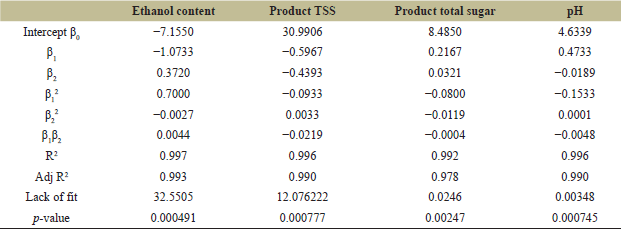 | Table 6. Regression coefficients of the predicted second-order polynomial models of yeast rate and fermentation time for the responses of dragon fruit beverage. [Click here to view] |
In our experiment, the R² values were between 0.992 and 0.997, and Adj R2 values were between 0.990 to 0.993, which indicates that our model provides a good fit to the data and is a strong predictor of the dependent variable, the yeast rate, and fermentation time. Besides, the p-values were all below 0.005, indicating that the model is statistically significant and that yeast rate and fermentation time significantly influence the dependent variables. However, a large lack of fit values in ethanol content and TSS content suggested that the model may still be missing some aspect of the data’s underlying structure.
The quadratic regression approach fitted to the experimental data provided insights into the relationship between the yeast rate and fermentation time and the resulting ethanol content, product TSS content, total sugar content, and pH (Table 6). The effect of independent variables on resulting dependent variables of dragon fruit beverage was shown as follows:
Ethanol content (% v/v)= -7.1550-1.0733*X1 +0.3720*X2 +0.7000*X12 -0.0027*X22 +0.0044*X1X2
TSS(Brix)= 30.9906-0.5967*X1 -0.4393*X2 -0.0933*X12 +0.0033*X22 -0.0219*X1X2
Total sugar (% v/v)= 8.4850+0.2167*X1 +0.0321*X2 -0.0800*X12 -0.0119*X22 -0.0004*X1X2
pH= 4.6339+0.4733*X1 -0.0189*X2 -0.1533*X12 +0.0001*X22 -0.0048*X1X2
in which X1 is the yeast rate (% v/v) and X2 is the fermentation time.
The positive coefficient for X1 suggested that an increase in the yeast rate tended to increase the product total sugar content and pH while tending to decrease the ethanol content and TSS content. However, the negative coefficients for X12 suggested a diminishing return effect, where very high values of X1 could decrease the product TSS content, total sugar content, and pH. On the other hand, the positive coefficient for X2 suggested that an increase in the yeast rate tended to increase the ethanol content and total sugar content while tending to decrease the TSS and pH values. Similarly, the negative coefficients for X22 suggested a diminishing return effect, where very high values of X2 could decrease the product ethanol content and total sugar content.
The response surface showed the relationship between yeast rate, fermentation time, the resulting ethanol content, pH, total sugar, and TSS during the fermentation process, which are plotted in Figure 3.
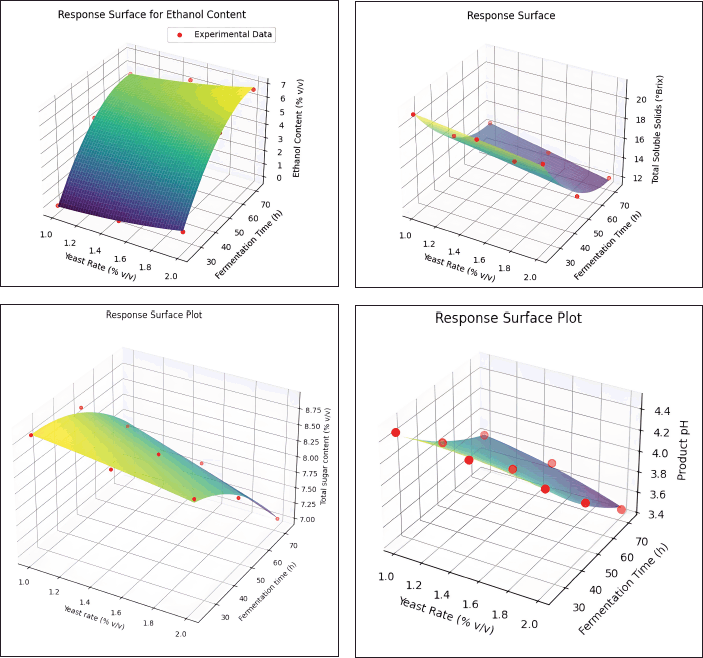 | Figure 3. The response surface shows the relationship between yeast rate, fermentation time, the resulting ethanol content, pH, total sugar, and TSS during the fermentation process. [Click here to view] |
The ethanol content increased with both increasing yeast rate and fermentation time (Fig. 3a). This trend is consistent with the basic principles of alcoholic fermentation, where yeast converts sugars into ethanol and CO2. Increasing the yeast rate from 1.0% to 2.0% v/v resulted in a significant increase in ethanol production. This suggests that the higher yeast concentration provided more active cells for fermentation, leading to more efficient sugar conversion. The ethanol content ranged from approximately 0% to 0.33% v/v at the lowest yeast rate (1.0% and 1.5% v/v) and shortest fermentation time (24 hours) to about 6.67% v/v at the highest yeast rate (2.0% v/v) and longest fermentation time (72 hours). While higher yeast rates produced more ethanol, extremely high rates might lead to yeast stress or autolysis. The optimal range for yeast addition appears to be between 1.5% and 2.0% v/v based on these data. The response surface provides valuable information for scaling up production, allowing producers to choose appropriate yeast rates and fermentation times based on desired ethanol content and production constraints. For instance, the continued increase in ethanol content up to 72 hours suggests that even longer fermentation times might yield higher alcohol content. However, this would need to be balanced against other factors such as flavor development and resource efficiency.
The TSS showed a similar trend to the total sugar content, decreasing with increasing yeast rate and fermentation time (Fig. 3b). The lowest values (around 12.07°Brix) were observed at the highest yeast rate and longest fermentation time. This decrease is consistent with the conversion of sugars to alcohol and other metabolic products during fermentation. This is similar to observations made by Giang et al. [31] in their study on green asparagus root fermentation. However, the rate of decline and final °Brix values may be specific to dragon fruit, warranting further investigation into the fruit’s unique carbohydrate composition and its impact on fermentation dynamics.
The total sugar content decreased with increasing yeast rate and fermentation time (Fig. 3c). The lowest sugar content (around 7.03% v/v) was observed at the highest yeast rate and longest fermentation time. This inverse relationship with ethanol content indicates that sugars are being consumed by yeast to produce alcohol during fermentation. The inverse relationship between sugar content and ethanol production is a fundamental aspect of alcoholic fermentation. Our results show a more rapid sugar decline at higher yeast concentrations, which is consistent with findings by Ribéreau-Gayon et al. [32] in their comprehensive work on wine fermentation. However, the residual sugar levels in our dragon fruit beverage may be higher than those typically found in dry wines, potentially due to the unique sugar profile of dragon fruit.
The pH of the fermented product decreased as both yeast rate and fermentation time increased (Fig. 3d). The lowest pH value (around 3.45) was observed at the highest yeast rate and longest fermentation time. This decline in pH is likely due to the production of organic acids during fermentation, which is more pronounced with higher yeast concentrations and extended fermentation period. The decrease in pH observed in our study is a common phenomenon in fruit fermentations. Kosseva et al. [24] reported similar pH reductions in various fruit wine fermentations. The final pH range (3.45–4.47) in our dragon fruit beverage is comparable to that found in many commercial fruit wines, suggesting potential microbial stability. However, further studies on the specific organic acids produced during dragon fruit fermentation could provide valuable insights into flavor development and preservation.
Sensory and Chemical Analysis of the Product After the Fermentation Optimization
Both yeast concentration and fermentation duration significantly impact the sensory characteristics of the final product (Table 7). The sensory parameters evaluated include color, odor, taste, and status, with scores ranging from 1 to 5, where higher values suggest better quality.
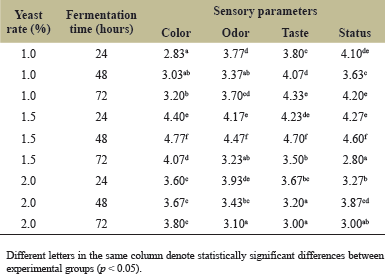 | Table 7. The statistical results present the influence of yeast ratio and fermentation time on the sensory attributes of dragon fruit products. [Click here to view] |
Among the tested combinations, treatment of 1.5% yeast ratio and 48 hours of fermentation consistently yielded the highest scores across all sensory attributes. This treatment produced a product with the most appealing color (4.77), pleasant odor (4.47), desirable taste (4.7), and optimal status (4.6). These results suggest that this particular combination of yeast concentration and fermentation time creates the most favorable sensory profile for dragon fruit products. Interestingly, increasing the yeast ratio to 2% or extending fermentation time to 72 hours generally led to decreased sensory scores. This trend implies that excessive yeast or prolonged fermentation may negatively impact the product’s sensory qualities, possibly due to overfermentation or the production of off-flavors and aromas.
The color attribute showed a notable improvement with increased yeast concentration up to 1.5% but declined at 2%. This suggests that moderate yeast levels enhance color development, possibly through the production of pigments or changes in the fruit’s structure during fermentation. Odor and taste scores followed similar patterns, peaking at the 1.5% yeast concentration and 48-hour fermentation time. This indicates a delicate balance in the fermentation process, where optimal conditions produce the most desirable flavor and aroma compounds.
These findings align with research by Huan et al. [30] who studied the fermentation of dragon fruit juice using S. cerevisiae. In their study, the optimal fermentation conditions of 2% yeast inoculation rate and 44-hour fermentation time, resulted in a “moderately like” flavor, which could be attributed to variations in dragon fruit beverage production. However, our results were found unsimilar to one study by Jiang et al. [33] on the fermentation of dragon fruit, where they observed the alcoholic fermentation with different yeasts: S. cerevisiae EC-1118, Torulaspora delbrueckii Biodiva, and Lachancea thermotolerans Concerto. In their study, better retention of antioxidant activity and color stability was found in L. thermotolerans and T. delbrueckii fermented wines than that of S. cerevisiae. They suggested that it is feasible to use pure non-Saccharomyces yeast to produce red dragon fruit wine for commercialization. This could be due to the different types of dragon fruits and the specific fermentation conditions, compared to our study.
All in all, this study demonstrates that a yeast ratio of 1.5% and a fermentation time of 48 hours produce the most favorable sensory attributes in fermented dragon fruit products. These findings contribute to the optimization of dragon fruit fermentation processes and highlight the delicate balance required to achieve desirable sensory characteristics. Further research could explore the biochemical changes occurring during fermentation to better understand the mechanisms behind these sensory improvements.
Final Product Evaluation
The analysis of the physical and chemical properties of the fermented dragon fruit beverage is presented in Table 8. The results are as follows.
 | Table 8. Physical and chemical properties of the final fermented dragon fruit beverage. [Click here to view] |
These findings indicate that the fermented dragon fruit beverage achieved an alcohol content of 4.53%, which was aligned with the principles of small and medium-scale fruit juice processing as outlined by Bates et al. [34]. Furthermore, the measured levels of soluble solids (22°Brix), pH (4.6), and total sugar content (8.32%) post-fermentation were within optimal ranges, contributing to favorable sensory qualities.
The sensory evaluation yielded a total score of 18.54 points, placing the product in the “good” category according to the TCVN 3215-79 quality classification standards. The product was characterized by a clear white color devoid of turbidity, a balanced sweet flavor, and the distinct state and aroma typical of dragon fruit.
Microbiological analysis, critical for determining product quality and consumer safety, is summarized in Table 9.
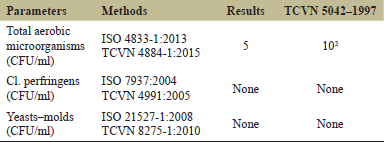 | Table 9. Microbiological analysis, critical for determining product quality and consumer safety of the final fermented dragon fruit beverage. [Click here to view] |
According to the microbiological test results shown in Table 9, it could be seen that the product has a total of five aerobic microorganisms, Clostridium perfringens and yeast–mold were not detected in the product. From the above microbiological test results, the fermented dragon fruit drink product with added natural yeast meets food hygiene and safety standards and ensures nutrition for users within the allowable limits of TCVN 5042 – 1997, thereby ensuring consumer safety and nutritional value.
In conclusion, the physical, chemical, and microbiological properties of the fermented dragon fruit beverage indicate that it is a high-quality product. The alcohol content, soluble solids, pH, and total sugar content are within desirable ranges, contributing to the product’s good sensory attributes. Moreover, the absence of harmful microorganisms underscores the beverage’s safety and compliance with national standards.
CONCLUSION
This study successfully demonstrated the potential of utilizing S. cerevisiae HG 1.3 as the primary fermentation agent in the production of a high-quality fermented dragon fruit beverage. The research identified optimal conditions for each stage of the fermentation process. A pectinase enzyme concentration of 0.04% significantly improved juice yield and clarity, addressing the challenges posed by the high pectin content in dragon fruit. The ideal fermentation conditions of 22°Brix soluble solids content and pH 4.6 provided an environment conducive to optimal yeast activity, resulting in a well-balanced flavor profile. Furthermore, a yeast ratio of S. cerevisiae HG 1.3% of 1.5% and commercial S. cerevisiae RV002 of 0.04% and a fermentation duration of 48 hours were found to produce the best quality juice, striking an ideal balance between alcohol content, flavor development, and overall sensory acceptance. Sensory evaluation and chemical analysis confirmed the high quality of the optimized fermented juice, with panelists rating it favorably for color, aroma, and taste. These findings not only contribute to the scientific understanding of dragon fruit fermentation but also offer practical guidelines for potential commercial applications in the beverage industry.
While this study has laid a strong foundation for dragon fruit juice fermentation using S. cerevisiae, several avenues for future research emerge, including: (1) further studies should focus on scaling up the fermentation process to industrial levels, addressing potential challenges in maintaining consistency and quality at larger volumes; (2) investigating the shelf-life of the fermented juice and developing strategies to enhance its stability during storage would be crucial for commercial viability; (3) exploring the possibility of incorporating probiotic strains alongside S. cerevisiae could enhance the health benefits of the fermented juice, and (4) detailed analysis of the flavor compounds produced during fermentation could lead to further refinement of the process and potentially the development of various flavor profiles.
In general, this research opens up exciting possibilities in the realm of tropical fruit fermentation, potentially leading to the development of novel, healthful, and flavorful beverages that could capture consumer interest in the ever-evolving functional food and beverage market.
AUTHOR CONTRIBUTIONS
All authors made substantial contributions to conception and design, acquisition of data, or analysis and interpretation of data; took part in drafting the article or revising it critically for important intellectual content; agreed to submit to the current journal; gave final approval of the version to be published; and agree to be accountable for all aspects of the work. All the authors are eligible to be an author as per the International Committee of Medical Journal Editors (ICMJE) requirements/guidelines.
CONFLICTS OF INTEREST
The authors report no financial or any other conflicts of interest in this work.
ETHICAL APPROVALS
This study does not involve experiments on animals or human subjects.
DATA AVAILABILITY
All the data is available with the authors and shall be provided upon request.
PUBLISHER’S NOTE
All claims expressed in this article are solely those of the authors and do not necessarily represent those of the publisher, the editors and the reviewers. This journal remains neutral with regard to jurisdictional claims in published institutional affiliation.
USE OF ARTIFICIAL INTELLIGENCE (AI)-ASSISTED TECHNOLOGY
The authors declares that they have not used artificial intelligence (AI)-tools for writing and editing of the manuscript, and no images were manipulated using AI.
REFERENCES
1. Kumar S, Tripathi V, Kumari A, Chaudhary V, Kumawat P. A-review: on nutritional and medicinal importance of dragon fruit (Hylocereus species). Ecol Environ Conserv 2022;28:247–53. CrossRef
2. Nguyen TD, Venkatadri U, Nguyen-Quang T, Diallo C, Adams M. Optimization model for fresh fruit supply chains: case-study of dragon fruit in Vietnam. AgriEngineering 2019;2:1–26. CrossRef
3. Tarte I, Singh A, Dar AH, Sharma A, Altaf A, Sharma P. Unfolding the potential of dragon fruit (Hylocereus spp.) for value addition: a review. eFood 2023;4:e76. CrossRef
4. Ismail N, Nawawi N, Ijod G, Anzian A, Ismail-Fitry M, Ahmad N, et al. Shelf life and quality assessment of pasteurised red dragon fruit (Hylocereus polyrhizus L.) purée: comparative study of high-pressure and thermal processing. Int Food Res J 2024;31:514–29. CrossRef
5. Le TT, Vu LT, Le NL. Effects of membrane pore size and transmembrane pressure on ultrafiltration of red-fleshed dragon fruit (Hylocereus polyrhizus) juice. J Chem Technol Biotechnol 2021;96:1561–72. CrossRef
6. Danalache F, Mata P, Alves VD, Moldão-Martins M. Fruit juices. Elsevier, Amsterdam, The Netherlands, pp 183–200, 2018. CrossRef
7. Sowbhagya H, Chitra V. Enzyme-assisted extraction of flavorings and colorants from plant materials. Crit Rev Food Sci Nutr 2010;50:146–61. CrossRef
8. Parapouli M, Vasileiadis A, Afendra AS, Hatziloukas E. Saccharomyces cerevisiae and its industrial applications. AIMS Microbiol 2020;6:1. CrossRef
9. da Silva Fernandes F, de Souza ÉS, Carneiro LM, Alves Silva JP, de Souza JVB, da Silva Batista J. Current ethanol production requirements for the yeast Saccharomyces cerevisiae. Int J Microbiol 2022;2022:7878830. CrossRef
10. Lin Y, Zhang W, Li C, Sakakibara K, Tanaka S, Kong H. Factors affecting ethanol fermentation using Saccharomyces cerevisiae BY4742. Biomass Bioener 2012;47:395–401. CrossRef
11. Park JM, Oh BR, Seo JW, Hong WK, Yu A, Sohn JH, et al. Efficient production of ethanol from empty palm fruit bunch fibers by fed-batch simultaneous saccharification and fermentation using Saccharomyces cerevisiae. Appl Biochem Biotechnol 2013;170:1807–14. CrossRef
12. Bezerra MA, Santelli RE, Oliveira EP, Villar LS, Escaleira LA. Response surface methodology (RSM) as a tool for optimization in analytical chemistry. Talanta 2008;76:965–77. CrossRef
13. Doan T, Huynh T, Nguyen D, Ha T, Ngo T. Total polyphenol content and antioxidant capacity of Cayratia trifolia (L) domin berries before and after fermentation using thermotolerant yeast Saccharomyces cerevisiae HG1.3. Vietnam J Sci Technol 2018;60:44.
14. Doan T, Vien H, Huynh X, Nguyen N, Bui H, Ha T, et al. Selection of thermotolerant yeasts and application in wine production from three-leaf cayratia (Cayratia trifolia L.) in Hau Giang. Can Tho Univ J Sci 2018;54:64–71. CrossRef
15. Tien DTK, Phong HX, Yamada M, Toan HT, Dung NTP. Characterization of newly isolated thermotolerant yeasts and evaluation of their potential for use in Cayratia trifolia wine production. Vietnam J Sci Technol Eng 2019;61:68–73. CrossRef
16. Amerine MA, Ough CS. Methods for analysis of musts and winesed. Wiley, New York, NY, 1980.
17. Liu HF, Wu BH, Fan PG, Li SH, Li LS. Sugar and acid concentrations in 98 grape cultivars analyzed by principal component analysis. J Sci Food Agric 2006;86:1526–36. CrossRef
18. Pinelo M, Zornoza B, Meyer AS. Selective release of phenols from apple skin: mass transfer kinetics during solvent and enzyme-assisted extraction. Separ Purific Technol 2008;63:620–7. CrossRef
19. Mufas A, Perera O. Study on development of pitaya fruit (Hylocereus undatus) incorporated ice cream: an alternative solution to the pitaya cultivators in Sri Lanka. In Proceedings of the Third International Symposium, SEUSL, 2013 July 6–7, Oluvil, 2013.
20. M’hir S, Mejri A, Atrous H, Ayed L. Optimization of parameters using response surface methodology to develop a novel kefir-like functional beverage from cheese whey enriched with myrtle juice. J Chem 2021;2021:2984470. CrossRef
21. Wang CY, Liu YW, Jia JQ, Sivakumar TR, Fan T, Gui ZZ. Optimization of fermentation process for preparation of mulberry fruit wine by response surface methodology. African J Microbiol Res 2013;7:227–36.
22. Al Daccache M, Koubaa M, Maroun RG, Salameh D, Louka N, Vorobiev E. Impact of the physicochemical composition and microbial diversity in apple juice fermentation process: a review. Molecules 2020;25:3698. CrossRef
23. Chakraborty S, Parab PV. Pulsed light treatment of table grape juice: influence of matrix pH on microbial and enzyme inactivation kinetics. Food Biosci 2023;53:102662. CrossRef
24. Kosseva MR, Joshi V, Panesar PS. Science and technology of fruit wine productioned. Academic Press, Cambridge, MA, 2016.
25. Alagöz Kabakc? S, Türky?lmaz M, Özkan M. Effects of fermentation time and pH on quality of black carrot juice fermented by kefir culture during storage. J Sci Food Agric 2022;102:2563–74. CrossRef
26. Wei M, Wang S, Gu P, Ouyang X, Liu S, Li Y, et al. Comparison of physicochemical indexes, amino acids, phenolic compounds and volatile compounds in bog bilberry juice fermented by Lactobacillus plantarum under different pH conditions. J Food Sci Technol 2018;55:2240–50. CrossRef
27. Whiting G. Organic acid metabolism of yeasts during fermentation of alcoholic beverages-a review. J Inst Brew 1976;82:84–92. CrossRef
28. Liaotrakoon W, De Clercq N, Van Hoed V, Van de Walle D, Lewille B, Dewettinck K. Impact of thermal treatment on physicochemical, antioxidative and rheological properties of white-flesh and red-flesh dragon fruit (Hylocereus spp.) purees. Food Bioproc Technol 2013;6:416–30. CrossRef
29. Wong YM, Siow LF. Effects of heat, pH, antioxidant, agitation and light on betacyanin stability using red-fleshed dragon fruit (Hylocereus polyrhizus) juice and concentrate as models. J Food Sci Technol 2015;52:3086–92. CrossRef
30. Huan P, Hien N, Anh N. Optimization of alcoholic fermentation of dragon fruit juice using response surface methodology. Food Res 2020;4:1529–36. CrossRef
31. Giang N, Tan N, Khai T, Tuyen V. Effect of initial total soluble solids and pH on the quality of fermented beverage from green asparagus roots (Asparagus officinalis L.). Food Res 2024;8:460–8. CrossRef
32. Ribéreau-Gayon P, Dubourdieu D, Donèche B, Lonvaud A. Handbook of enology, Volume 1: the microbiology of wine and vinificationsed. John Wiley & Sons, Hoboken, NJ, 2006. CrossRef
33. Jiang X, Lu Y, Liu SQ. Effects of different yeasts on physicochemical and oenological properties of red dragon fruit wine fermented with Saccharomyces cerevisiae, Torulaspora delbrueckii and Lachancea thermotolerans. Microorganisms 2020;8:315. CrossRef
34. Bates RP, Morris JR, Crandall PG. Principles and practices of small-and medium-scale fruit juice processinged. Food and Agriculture Organization, Rome, Italy, 2001.